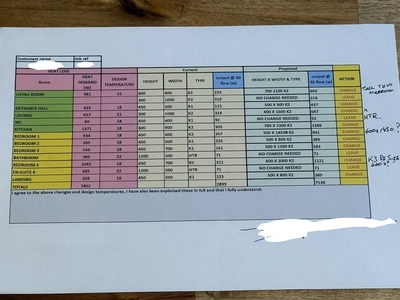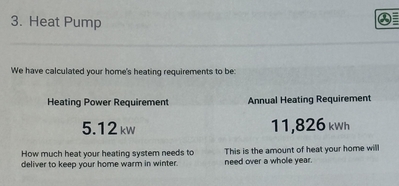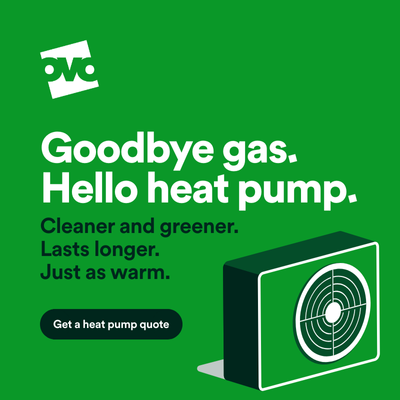Sizing a heat pump: Save me from my headache
First up, I apologise in advance. I have tried to consume a vast amount of information, some of it I understand, some of it I do not, but all of it I believe forms part of a puzzle I’m trying to solve.
I am looking at getting a heat pump installed, replacing a 15kw gas boiler and 150L UVC that sits in the region of 65 degrees with a pump, size to be determined, with a cylinder I believe needs to be 250L+ (4 bed, 3-5 occupants).
First problem, easily answered - space heating. We’ve had a few estimates, all either side of 5kw. That - for the brands we’re looking at (Vaillant, Daikin and Mitsubishi) - is an easy answer; the Vaillant 7kw, and the Daikin and Mitsubishi 6kw.
The concern I have is keeping that cylinder warm during use. Whilst we’re not hot washing cars and running five baths at once, I am worried that as we drop cylinder temperature to 50 or even 45 ideally we will start to become more dependent on heating water quickly after it is used. 6kw doesn’t go very far in that context.
Looking at all of the information, it appears that the Daikin and Mitsubishi 8kw (not the 8.5) are physically very similar to the 6kw and as a result from a modulation standpoint make no difference in the mild seasons, but provide substantial benefit for DHW. Is this correct?
If it is correct, where is the 8kw Mitsubishi R290 going? It seems to be on it’s way out having survived a whole year before they introduced the 8.5kw, which as far as I can tell is a bigger starting point resulting in higher lowest output numbers?
Sorry for all this. My brain is absolutely addled trying to understand all of this and I’m faced with a very long term decision with sales speak pulling me multiple directions.
@mikeatthezoo , you said you’ve had some estimates. Did you layout all these queries to the suppliers who quoted you. Did they provide any advice?
If you have enough space, you might consider opting for a larger hot water cylinder. That would reduce the risk of running out of hot water. However, it would also take more energy, and therefore heating time, to warm the whole tank.
Grant Aerona 290 15.5kW, Grant Smart Controller, 2 x 200l cylinders, hot water plate heat exchanger, Single zone open loop system with TRVs for bedrooms & one sunny living room, Weather compensation with set back by room thermostat based load compensation
Posted by: @mikeatthezooit appears that the Daikin and Mitsubishi 8kw (not the 8.5) are physically very similar to the 6kw
Mitsi 8kW has a 6kW variable and 2kW fixed compressor so presumably modulates down to the same as the 6kW.
All Daikin models <= 8kW are same hardware sofaik, limited in the firmware.
Posted by: @mikeatthezooit is correct, where is the 8kw Mitsubishi R290 going?
No idea. It's currently an interesting unicorn with two compressors. I assume destiny will depend on sales.
Posted by: @mikeatthezooI am worried that as we drop cylinder temperature to 50 or even 45 ideally we will start to become more dependent on heating water quickly after it is used. 6kw doesn’t go very far in that context.
Suggest to work out your use pattern if this is a concern. There is no substitute for doing the arithmetic
4kW peak of solar PV since 2011; EV and a 1930s house which has been partially renovated to improve its efficiency. 7kW Vaillant heat pump.
@mikeatthezoo , you said you’ve had some estimates. Did you layout all these queries to the suppliers who quoted you. Did they provide any advice?
I did; Octopus won’t budge on their design flow temp (predictable issue) but also won’t relent on the 6kw; it’s also their R32 and I think at this point my preference is R290 as not being dependent on the immersion for legionella cycle has cost benefits. Both others are quite happy to go up a size in terms of heat pump but aren’t specifically clear on how likely I am to encounter short cycling, both are “happy” to design around that.
Posted by: @grahamf
If you have enough space, you might consider opting for a larger hot water cylinder. That would reduce the risk of running out of hot water. However, it would also take more energy, and therefore heating time, to warm the whole tank.
We’re going to 300 litres, but as you allude to every time we increase in size we increase the time it takes to heat because of the amount of energy it takes to achieve that. That said, going for the R290 model does allow me to (for the time where demand might be a challenge) increase cylinder temperature to address some of my concern.
Posted by: @jamespaPosted by: @mikeatthezooit appears that the Daikin and Mitsubishi 8kw (not the 8.5) are physically very similar to the 6kw
Mitsi 8kW has a 6kW variable and 2kW fixed compressor so presumably modulates down to the same as the 6kW.
All Daikin models <= 8kW are same hardware sofaik, limited in the firmware.
Posted by: @mikeatthezooit is correct, where is the 8kw Mitsubishi R290 going?
No idea. It's currently an interesting unicorn with two compressors. I assume destiny will depend on sales.
Posted by: @mikeatthezooI am worried that as we drop cylinder temperature to 50 or even 45 ideally we will start to become more dependent on heating water quickly after it is used. 6kw doesn’t go very far in that context.
Suggest to work out your use pattern if this is a concern. There is no substitute for doing the arithmetic
That explains the differences between the 6 and 8 for both thank you; I spoke to Mitsubishi UK who said that the 8 is indeed discontinued owing to not meeting their expectations - efficiency and reliability were both mentioned, with the former not being the biggest of concerns (it’s less efficient than their 8.5 at 8, but it is the same efficiency below 6 as the smaller units). They’re waiting for the design to review it their side for any concerns, which I should have at the end of this week.
Use pattern is what concerns me - most days we’ll drop a 143 litre tank from 60-65 degrees to 30-35 degrees a minimum of twice, as the wife showers both ends unsympathetically to the energy bill and son does every other day as well, usually opposing me but sometimes same day.
Having the heat pump reheat the cylinder for 60-90 minutes three times a day feels like we might end up risking climate comfort, but trying to modulate the Mitsubishi 8.5 down to the 2.8kw (50% of heat loss calcs) is a razor thin margin.
Posted by: @mikeatthezooHaving the heat pump reheat the cylinder for 60-90 minutes three times a day feels like we might end up risking climate comfort, but trying to modulate the Mitsubishi 8.5 down to the 2.8kw (50% of heat loss calcs) is a razor thin margin.
Lets look at this the other way round. If your loss is 5kW and your heat pump can do 6.5 (absolute worst case with the Vaillant so far as can be told) you have 1.5*24kWh to spare each day even on the worst day. If push came to shove you could add another 3*24kWh by turning the immersion on.
Assuming you shower at 40C and the input water is 10C then each litre of shower water consumes 126kJ. So each kWh will heat 28l of water. Thus 36kWh will heat 1cu m of water. Unless I have made a mistake you have plenty to spare. A bit of thought with the scheduling should sort it. I think you may be worrying unnecessarily.
4kW peak of solar PV since 2011; EV and a 1930s house which has been partially renovated to improve its efficiency. 7kW Vaillant heat pump.
Posted by: @jamespaLets look at this the other way round. If your loss is 5kW and your heat pump can do 6.5 (absolute worst case with the Vaillant so far as can be told) you have 1.5*24kWh to spare each day even on the worst day. If push came to shove you could add another 3*24kWh by turning the immersion on.
Assuming you shower at 40C and the input water is 10C then each litre of shower water consumes 126kJ. So each kWh will heat 28l of water. Thus 36kWh will heat 1cu m of water. Unless I have made a mistake you have plenty to spare. A bit of thought with the scheduling should sort it. I think you may be worrying unnecessarily.
That is fair - my main goal is to ensure that I don’t end up in the position of having to “watch” cylinder temps and I appreciate that is something I’m going to have to manage my way out of after the initial installation through scheduling and temperature changes.
i appreciate there’s a whole heap of mentality changes in moving to a heat pump, but I do draw the line at getting yelled at from a cold shower!
If you get an R290 pump you should be able to heat the tank to 65C which will give you 550l of water at 40C from a 300l tank. You probably don't want to stay with that setting as cop will be poor, but it could get you started whilst you are working things out!
Cylinder temp sensors are often about half way down, worth bearing in mind. With decent stratification you might have quite a lot left even with your current setup before the shower goes cold.
4kW peak of solar PV since 2011; EV and a 1930s house which has been partially renovated to improve its efficiency. 7kW Vaillant heat pump.
Got the results back from the one we’re proceeding with; rads will all have manual TRVs but the only ones likely to be set are the two larger bedroom ones; all in one zone, will have a 100l volumiser on the flow side of the heating loop and the cylinder will be a 300 litre cylinder.
Heat pump will be the 8.5kw R290 Ecodan; bigger than necessary but hopefully with the design accommodating for that it deals with our desires around the water cylinder and manages the space heating in a way that the pump is happy with. Expected SCOP from the design is 4.49.
- 26 Forums
- 2,360 Topics
- 53.5 K Posts
- 222 Online
- 6,026 Members
Join Us!
Worth Watching
Latest Posts
-
RE: Mitsubishi Ecodan R290 10kW performance
@sheriff-fatman The FTC7 with third party cylinder and...
By Ecoste , 12 minutes ago
-

RE: My Powerwall 3 Consumes 3-4 kWh/Day in Self-Consumption: Is This Normal?
@caron, I'm looking into this for you... from my own pe...
By Mars , 2 hours ago
-
RE: New Fogstar 15.5kWh upright solution
SITREP #5 (I think) Milestone completed toda...
By GGW , 4 hours ago
-
RE: Octopus Cosy Heat Pump Owners & Discussion Thread
The FT levels off at either the set point OR the minimu...
By AndrewJ , 4 hours ago
-
RE: MyVaillant Connect Regular Disconnect
Thanks. Yes, if the time is consistently 11pm every nig...
By buckwem , 4 hours ago
-

RE: Speedcomfort radiator fans
My take on Speedcomfort radiator fans: If anyone w...
By Mars , 10 hours ago
-
RE: Midea ASHP – how to set weather compensation
@pash44pump I have yet to come across any Clivet or Mid...
By benson , 11 hours ago
-
RE: Who's your electricity provider and what's your tariff?
@transparent Thanks, this helps. Could it be that St...
By Batpred , 11 hours ago
-
RE: Clivet ASHPs and weather compensation
Simon did share a lot of very helpful advice. On furthe...
By ambris , 11 hours ago
-
RE: Home Assistant vs ESPAltherma.
@majordennisbloodnok Thanks very much.
By Ubert767 , 12 hours ago
-

RE: Setback savings - fact or fiction?
I could, but I think we can do better, by plotting hour...
By cathodeRay , 1 day ago
-
RE: Advice on internal circulation pump noise
Extend the primary branch and make sure you have more t...
By ASHP-BOBBA , 1 day ago
-

RE: External pipework insulation
Oh Dear! that's appalling pipe work, should've been in ...
By dgclimatecontrol , 1 day ago
-

RE: Jokes and fun posts about heat pumps and renewables
By Morgan , 2 days ago
-

RE: Controlling Daikin Altherma via P1P2 and Home Assistant
On the contrary, @toodles, that’s a lot of help. I’d ne...
By Majordennisbloodnok , 2 days ago
-

Parsnip, Bacon & Coconut Milk Soup
First let me say, I am only a cook because I am human a...
By Toodles , 2 days ago
-
RE: Electricity price predictions
Ben Watts posted on LinkedIn that he had updated this w...
By Judith , 2 days ago
-

RE: The good, the bad and the not that great – my heat pump installation
Small update, Emailed and Spoke to Midea UK and they ...
By Burtis , 2 days ago






